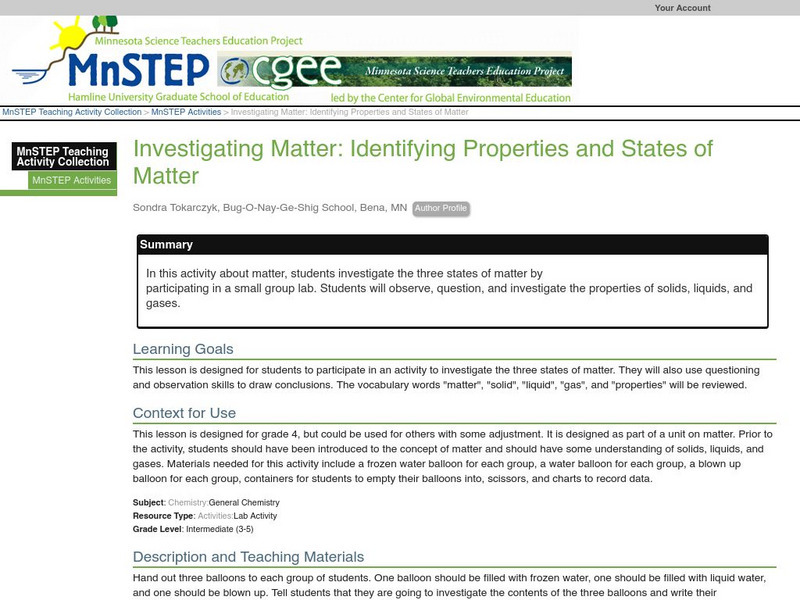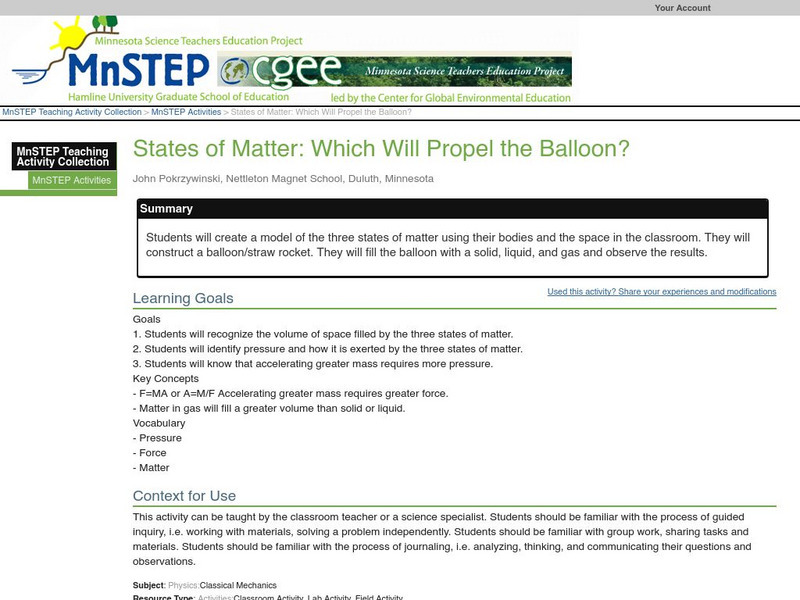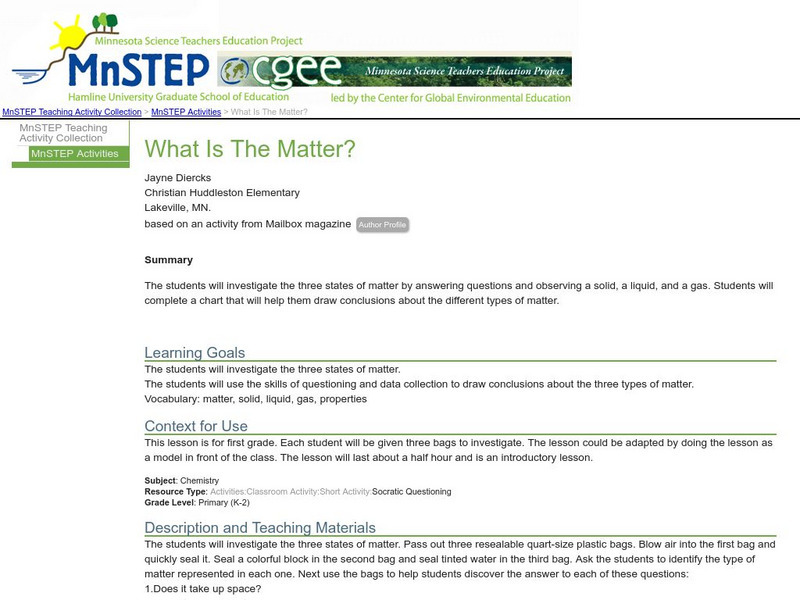Curated OER
My Love And I
Students practice singing the song "My Love And I" by Sonja Poorman and Berta Poorman in this High School music lesson for the SSA choir. This lesson can be accomplished in under an hour and includes warm-up ideas to begin the class.
Curated OER
A Funky Healthy Life Style!
Learners name the five food groups and classify foods according to group. They tell how proteins, carbohydrates, vitamins/minerals, and water help their body. Students discuss how play and exercise can help their body.
Curated OER
Shape Makes a Difference!
Students learn the difference between perimeter and area by watching a video and a hands on activity.
Curated OER
Good Vibrations
Students demonstrate sound waves and make changes in the waves
resulting in changes in pitch. Students associate changes in pitch in various "musical instruments"with size and shape and the sound waves they produce.
Curated OER
Keep Your Lamps
Students practice their singing using the correct posture. Using music, they practice reading it and using the correct rhythm. They are introduced to a Oratorio and stretching exercises to use before beginning a song. They share their...
Curated OER
Festival Hosanna
Students sing and perform the song "Festival Hosanna" by Carole Stephens in this Choral lesson for the High School classroom. Emphasis is placed upon the National Standards for Music and singing proper Latin text in a group setting.
Curated OER
Fact Families
Fifth graders explore fact families. They solve simple math problems. Students determine which mathematical property is used to solve the given problem. They are given five minutes to complete as many mathematical facts as possible.
Curated OER
How Can You Study Things You Can’t See Like: Atoms?
Students simulate how scientists studied things they can't see like atoms. In this chemistry lesson, students predict what is inside the numbered obsertainers. They design a way to investigate what's inside without opening it.
Curated OER
Code Breakers
Students collect data and make a frequency table, change ratios into percents, and analyze data to make predictions.
Curated OER
Brainstorming Solutions
High schoolers discuss common problems and interests with their classmates as a vehicle for problem solving. After sharing their problems, students work in groups to brainstorm possible solutions to their problems. This lesson plan is...
Curated OER
Coal and the Environment
Students read about how burning coal affects the environment. After students finish reading about how burning coal affects the environment they have a group discussion to discuss what they thought about the information.
Curated OER
"Region" Out to Everyone: Geographic Regions Defined
Students define the term region. They collect data about New England after watching a short video. They organize the information into a regional concept map. They draw conclusions based upon their data collection and analysis.
Curated OER
Relief Block Prints
Fourth graders design a space using line and shape and recognize relief block prints from Japan and appreciate their design.
Science and Mathematics Initiative for Learning Enhancement (SMILE)
Smile: Three States of Matter
Teachers can find an interactive lesson plan for introducing the three states of matter to the early elementary student using items that they are familiar with. This also includes gathering data and filling in a table, an important part...
Science Education Resource Center at Carleton College
Serc: Exploring States of Matter Gases
In this series of chemistry labs, young scholars learn about the three states of matter by observing how molecules contract or expand as they change state.
ArtsNow
Arts Now Learning: States of Matter [Pdf]
In this lesson, students will move and generate choreography to understand different states of matter.
Science Education Resource Center at Carleton College
Serc: Investigating Matter: Identifying Properties and States of Matter
In this activity about matter, students investigate the three states of matter by participating in a small group lab. Students will observe, question, and investigate the properties of solids, liquids, and gases.
Science Education Resource Center at Carleton College
Serc: The Three States of Matter
In this Physical Science exploration activity, learners explore the meaning of the words solid, liquid, and gas. Student groups complete a chart with examples of each type of matter and its properties and then record their observations...
Science Education Resource Center at Carleton College
Serc: Mn Step: States of Matter: Which Will Propel the Balloon?
For this activity, students take part in a simulation of the three states of matter where they role play being molecules. They then create simple balloon rockets and must explain why a gas is the only state of matter that can cause the...
Science Education Resource Center at Carleton College
Serc: Mn Step: What Is the Matter?
Students will examine a solid, a liquid, and a gas to gather information and draw conclusions about the three states of matter.
American Chemical Society
Middle School Chemistry: Chapter 1: Solids, Liquids, and Gases
Five exemplary chemistry lessons about the three states of matter complete with handouts and animations.
Science Education Resource Center at Carleton College
Serc: Freezing and Phase Change: How Do You Make Ice Cream?
Students will be expanding a study of phase changes after experiences with exploration of the three phases of matter. They apply what they have learned through freezing water and create a tasty ice cream treat.
Alabama Learning Exchange
Alex: Why Comparative Embryology Matters in the Real World
In this lesson, students compare similarities in the embryos of different organisms to look for features that would indicate common ancestry. They will then investigate how understanding this aspect of evolution has real-world...
HotChalk
Hot Chalk: Lesson Plans Page: Science Lesson on Water
This activity will teach students about the three states of water found on our planet: solid, liquid gas. They will learn to distinguish the differences between these states and will be able to give examples of each.















![Arts Now Learning: States of Matter [Pdf] Lesson Plan Arts Now Learning: States of Matter [Pdf] Lesson Plan](https://static.lp.lexp.cloud/images/attachment_defaults/resource/large/FPO-knovation.png)





